Index
CPU, RAM and SoC Design Changes
When most companies go through the enormous expense of designing a complex chip, they usually never hesitate to tell the entire industry about it, which in turn riles up prospective consumers through a proliferation of flattery over various social media networks. Whether that information is transmitted through a whitepaper, a keynote, a press release or bite-sized snippets revealed to a select chosen few, word of a new processor or SoC design coming to market almost always materializes before the product hits store shelves. Unfortunately, this has never been the case with Apple. At this point, the company has it pretty much baked into its corporate culture that its secretive product cycle philosophy is one of the best practices it has ever chosen to maintain. Nevertheless, most argue in support of the idea that Steve Jobs simply loves secrets, and that they give him an elevated foothold over an industry filled with assumptions and speculations.
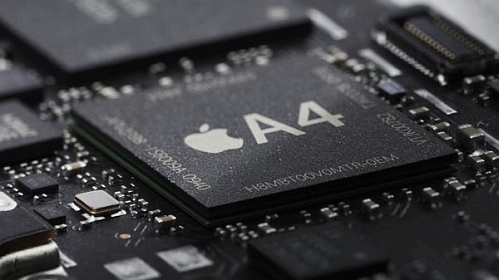
Whatever its motives may be, Apple decided not to reveal the specifications of its A4 processor during the iPad’s announcement in January, and only revealed the name of the processor itself. Of course, little did the industry know that the company would implement the same processor in its fourth-generation smartphone. Now that the product has materialized and has sold over 1.7 million units within its first three days, we can confirm without question that the device sports the same ARM-based 45nm A4 1GHz chip used in the iPad. But rather than being clocked straight at 1GHz, the A4 processor in the iPhone 4 runs at a variable clockspeed, allowing it to vary in speed and adjust according to application demands. It features a maximum clock of 1GHz just like the iPad, but for most applications it will essentially mimic Intel’s SpeedStep platform by adjusting voltages and clock speeds according to the number of applications running to improve power consumption efficiency.
In retrospect, the iPhone 3GS featured a 65nm ARM Cortex A8 with a 600MHz clock speed and 256MB of breathing room. By contrast, the iPhone 4 has been upgraded to a variable clock speed Cortex A8-based SoC that possibly runs between 750MHz and 800MHz most of the time. AnandTech was curious about the exact performance improvements between the two latest iPhone generations and conducted a few SunSpider Javascript performance benchmarks between some of Apple’s top competing 2010 smartphones, including the iPhone 3GS and the iPad. The results show that the iPhone 4 processor manages an overall score that is 25 percent faster than the iPhone 3GS processor in all of its CPU-specific tests. Given Apple’s unwillingness to discuss the architecture of its new phone, AnandTech assumes a safe bet that the ARM Cortex A8-based A4 chip runs around 800MHz in the iPhone 4 and 1GHz in the iPad.

(Flagship smartphone hardware comparison - AnandTech.com)
Memory has also been an interesting topic of discussion in the iPhone 4, as many analysts are now finding that the new device sports 512MB of onboard RAM (503MB of which is available to the OS and applications) opposed to the iPad’s 256MB. This was confirmed by iFixit.com’s teardown of the device right around launch time. The site notes that the increase in RAM allows for a larger amount of cached data, resulting a smoother and faster user experience.
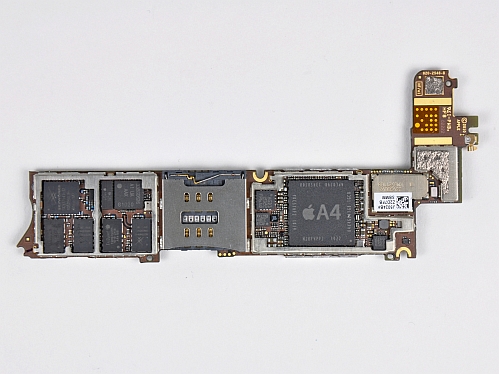
(iPhone 4 SoC - iFixit.com)
Alongside the A4 processor is the same PowerVR SGX 535 graphics chip found in the iPhone 3GS. Anand Shimpi went into great detail last year about Imagination Technologies’ fifth generation PowerVR architecture, a tile-based renderer that divides the screen up into small blocks, or tiles, and renders each one independently. In his iPhone 3GS review, he noted that this approach to graphics rendering is particularly important in the mobile space because there simply isn’t enough available bandwidth, and the mere milliwatts of power that smartphones are intended to consume isn’t enough to drive a full scale rendering architecture.
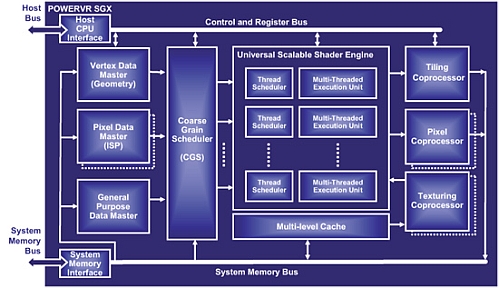
(Imagination Technologies fifth-generation PowerVR SGX architecture diagram)
From our experience over these past three weeks, the iPhone 4 definitely provides a snappier overall user experience than the iPhone 3GS, and we aren’t ones to complain about any aspects of the CPU/GPU/DRAM hardware combo that Apple decided to implement in this generation. Despite not having a 1GHz Qualcomm Snapdragon processor like the HTC Incredible and HTC EVO 4G, we’ve found that the iPhone 4 adequately meets our expectations and even rivals HTC's offerings in terms of hardware performance (although Apple iOS software performance versus Google Android software performance is an entirely different topic).
We also ran a quick series of SunSpider JavaScript benchmark tests in mobile Safari to more accurately quantify the performance differences between Apple's mobile devices in web browsing. It's important to note that SunSpider tests tend to substitute the "micro benchmarks" found in Google's V8 tests in favor of real-world operations similar to those that developers perform. According to the results, the iPhone 4 sits right in between the 3GS and the iPad.
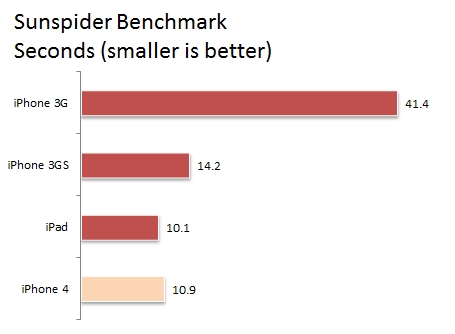
The iPhone 4 hardware also incorporates a new 3-axis gyroscope in addition to the accelerometer. The combination of these two sensors will ultimately provide 6-axis motion sensing (see: PlayStation 3 SIXAXIS Wireless Controller), and using the CoreMotion APIs, application developers can make use of the gyroscope to roll, pitch and yaw. With six degrees of rotation in a compact physical space, Apple hopes that its developers will design even more immersive gaming experiences that enable gamers to have full control over their virtual environments.
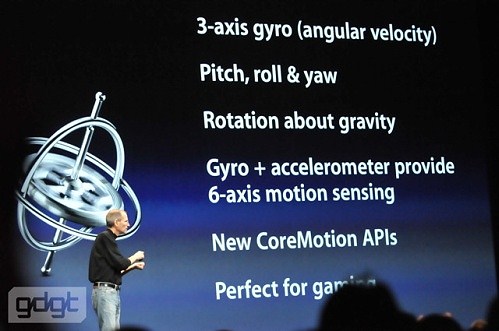
(iPhone 4 gyro announcement during Apple's WWDC 2010 keynote)



